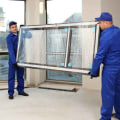When it comes to improving a home's overall performance, comfort, and sustainability, replacing outdated windows and doors stands as one of the most impactful changes a homeowner can make. Old, drafty, or poorly insulated window and door units can lead to significant energy loss, making HVAC systems work overtime and inflating utility bills. Investing in modern, energy-efficient designs not only helps reduce environmental impact but also enhances interior comfort and adds to a home's market value. These upgrades are essential, especially in regions where temperature shifts or seasonal extremes require dependable indoor climate control.
Energy Loss Through Old Fixtures
The average home loses 25% to 30% of its heating and cooling energy through windows and doors, according to energy experts. Over time, gaps form in weather stripping, seals degrade, and outdated glass fails to insulate effectively. These issues cause indoor temperatures to fluctuate, triggering more frequent cycles from heating and cooling systems. When homeowners opt for energy-efficient alternatives such as double- or triple-pane windows with low-emissivity (low-E) coatings, or insulated steel and fiberglass doors, they significantly reduce this energy drain. These products are engineered to block heat transfer, resist condensation, and seal out air leaks that contribute to wasted energy.
The Role of Advanced Materials and Installation
Technology has come a long way in producing durable and efficient window and door materials. Vinyl, fiberglass, and composite frames offer much better insulation than old aluminum or single-pane units. Similarly, multi-point locking systems and tighter thresholds improve security while also enhancing the air-sealing capability of doors. But materials alone aren’t the full story—professional installation is just as critical. Even the most advanced windows and doors will underperform if installed improperly. Gaps, misalignments, and inadequate sealing around frames can still lead to energy loss. That’s why partnering with experienced contractors who specialize in precision installation is key to getting the full energy-saving benefits.
Added Benefits Beyond Energy Savings
Beyond slashing monthly energy bills, new windows and doors offer a range of additional advantages. Many homeowners report noticeable improvements in indoor comfort, such as fewer drafts, more consistent room temperatures, and reduced outside noise. In addition, new designs often come with UV protection to safeguard flooring and furniture from sun damage. Improved curb appeal and a fresh, updated look also make these upgrades a smart aesthetic investment, especially for those considering selling their property in the near future. In fact, energy-efficient improvements are consistently ranked among the top renovations with strong return on investment in real estate.
The Bigger Picture of Sustainable Living
Energy-efficient windows and doors are part of a broader commitment to sustainable, responsible homeownership. These upgrades align with efforts to reduce carbon footprints, lower reliance on fossil fuels, and contribute to healthier indoor air quality by minimizing drafts and excess moisture. Homeowners can further enhance their energy goals by combining new window and door installations with upgraded insulation, smart thermostats, and energy-efficient lighting and appliances.
Final Thoughts
Ultimately, the decision to replace outdated windows and doors is not just about aesthetics—it's about making a strategic investment in the long-term comfort and energy performance of your home. Whether you're preparing for colder months or looking to lower your cooling costs in the summer, the benefits of high-performance windows and doors are tangible and lasting. For those considering home remodeling in Bluffton, updating your windows and doors should be a top priority on your checklist. With the right materials, expert installation, and a focus on energy efficiency, you can truly seal the deal and enjoy a cozier, more efficient living space year-round.







